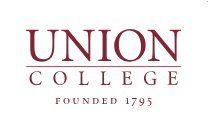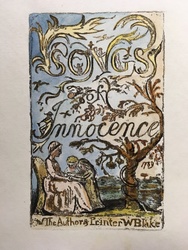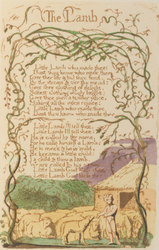Techniques
William Blake’s printing techniques and style were as inventive as his writings. Hands-on efforts to recreate and fully understand Blake’s working methods continue to engage researchers and makers of facsimiles worldwide, especially because copies of Blake’s original works are so rare and difficult to access.
Blake’s Techniques:
Blake’s process for printing his work involved four stages: the initial design; the creation of a metal printing plate; the printing of proofs and final copies on paper (sometimes with colored inks or washes); and hand coloring with watercolor to enhance the printed images. Many examples exist of Blake’s designs for commercial work that was later meant to be engraved (such as his illustrations for Edward Young’s Night-Thoughts and the Book of Job), but for his own books Blake may have gone directly to the next stage, creating a copper printing plate.
Several theories exist as to Blake’s method for creating the plates, which combine text and visual imagery in intricate detail. An expert engraver accustomed to developing images “backwards,” Blake is generally thought to have etched his plates in reverse, or in a mirror image of the final printed product. Afterwards the plates were covered in acid to create a relief copy for printing purposes. Another theory, however, suggests that he used a transfer method to simplify the process. In either case, the laborious process of creating each plate was followed by the printing of proofs, which involved inking the plate and pressing the image onto paper one print at a time using a hand-operated rolling printing press.
Blake experimented with a variety of ink colors for his text, including various browns and green. On occasion he also added washes of color to the copper plate in an attempt to color his images through the printing process. More commonly, however, his prints on paper were later hand-colored with watercolor pigments that Blake ground himself and then applied in layers to achieve the desired effect. His wife Catherine is believed to have assisted him at nearly every stage of the process. The style and intensity of the colors that Blake used changed over time, even when he colored an image designed much earlier. Thus each print or copy of Blake’s illuminated works is unique. The combined effect of the many steps and hand work required for the production of the finished prints, as well as the limited number that Blake and Catherine were able to make and sell, are what account for the scarcity of original copies.
Facsimile Techniques:
Efforts to reproduce Blake’s work have employed a variety of techniques. The advent of digital technology has allowed the majority of the surviving copies of Blake’s original output to be scanned and made available with magnificent clarity at the non-profit research site, the William Blake Archive. The Archive is an essential tool for any student of Blake’s work, and links to it are provided throughout this site. Printed facsimiles such as those in the Union College collection, however, still have tangible and irreplaceable benefits, even when they lack the fidelity of scans at the William Blake Archive. Blake’s works remain especially stimulating and vibrant on the page. In the words of Union College student Caitlin Williams ’18: “Holding a reproduction of one of his books in your hands, flipping over each individual page, provides an intimate experience between the reader and the text and visuals that cannot be replicated by technology. It is also one step closer to the works that Blake actually produced, vividly demonstrating what the work would have looked like, how big it was, and the overall physical and visual impact that Blake intended.”
Early facsimiles such as William Muir’s Songs of Innocence and Experience, first produced in limited editions in the late 19th century and for the centenary of Blake’s death in 1927, were entirely hand printed and colored in an exacting effort to reproduce original copies held by the British Museum. A century later, digital reproduction and printing techniques allowed a far greater number of copies to be made of works that were previously impossible to reproduce at all, such as Blake’s 527 watercolor designs for Edward Young’s NightThoughts, published by the Folio Society in 2005.
Appearing in between these two types of facsimiles in the second half of the 20th century, the Trianon Press undertook for the William Blake Trust a landmark project to publish faithful facsimiles of the full extent of Blake’s illuminated books as well as selected other work. Rag paper similar to that used by Blake was printed with images of his plates by the collotype method (a photomechanical process that exposes a thin layer of gelatin on the printing plate to a negative of the original image, allowing the print to be reproduced over and over again with no degradation in quality). Trianon’s team then recreated the coloring of the specific copy of Blake’s work that they were using as a model, employing stencils to guide the hand-painting of each layer. Union College holds a complete set of the Trianon facsimiles, including several in multiple copies or special editions that include the stencils or steps in the collotype process demonstrating the techniques that Trianon used to reproduce Blake’s work as accurately as possible.
Also represented in the library’s collections are facsimiles of Songs of Innocence and of Experience produced by independent printers attempting to imitate more closely Blake’s working methods. The Manchester Workshop edition of 40 copies in 1983 used a more modern chemical method, electrotyping, rather than relief etching to create its printing plates, but it employed techniques similar to Blake’s in mixing watercolors, and its staff colored each plate in a vibrant free-hand style in direct imitation of a model edition by Blake rather than through the use of stencils. In 2016 Michael Phillips also created a copper plate by more modern methods, using photographic means to copy Blake’s image onto a plate before etching it. Like Blake, however, Phillips experimented with different colors of historically accurate inks and inking methods, and he produced his edition of 20 copies on a reproduction of a rolling printing press like the one that Blake and his wife would have used. More about Phillips’ methods of production can be found at his website.
In 2001 students at Union explored the techniques used to recreate various facsimiles of Blake’s Songs in an exhibit with a catalog that can be accessed here.






